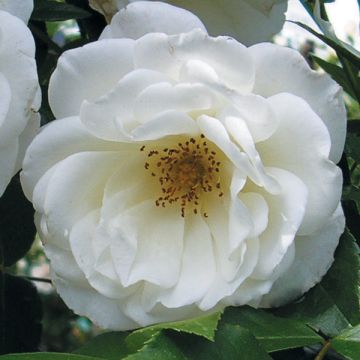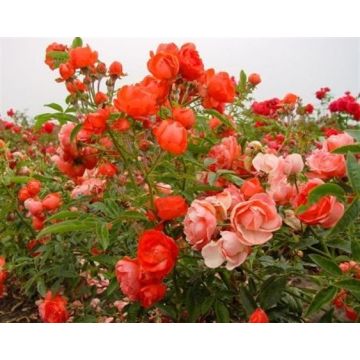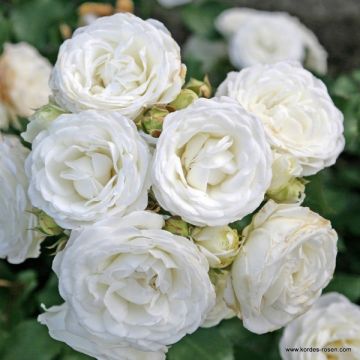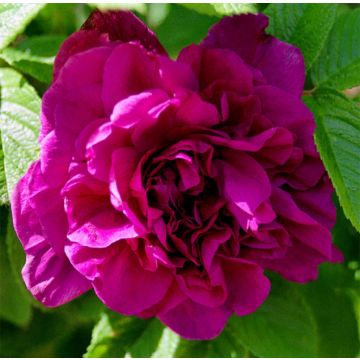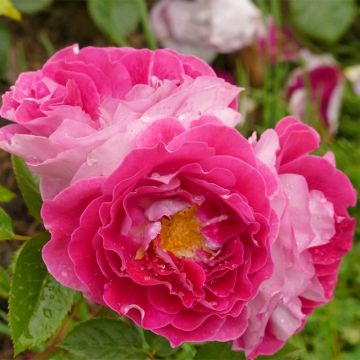

Rosa Bees Paradise Pink - patio rose
Rosa Bees Paradise Pink - patio rose
Rosa x polyantha Bees Paradise® Pink
Rosier polyantha
This item cannot be shipped to the selected country
Delivery charge from €5.90
Delivery charge from €5.90
Delivery to Corse prohibited
More information
Schedule delivery date,
and select date in basket
This plant carries a 24 months recovery warranty
More information
We guarantee the quality of our plants for a full growing cycle, and will replace at our expense any plant that fails to recover under normal climatic and planting conditions.
From €5.90 for pickup delivery and €6.90 for home delivery
Express home delivery from €8.90.
From €5.90 for pickup delivery and €6.90 for home delivery
Express home delivery from €8.90.
Delivery to Corse prohibited: UE law prohibits the import of this plant from mainland France to Corse as part of the fight against Xylella fastidiosa. Please accept our sincere apologies.
More information
Does this plant fit my garden?
Set up your Plantfit profile →
Description
Rosa Bees Paradise Pink, with its small, almost single bright pink flowers, is part of a collection of compact roses developed by German rose breeder Tantau to attract and feed bees. Forming beautiful and easy-to-care-for flowering cushions, all offer a large, easily accessible heart of pollen-rich stamens. This one has a lower and wider habit than the other Bee's Paradise varieties, making it a beautiful ground cover. Its perpetual flowering and small size allow it to be grown in gardens of any size or in containers on the terrace.
The flowers of Bees Paradise Pink rose are gathered in small terminal clusters, inherited from the polyantha rose, an old hybrid derived from Rosa multiflora and R. chinensis. They are particularly rich in nectar and pollen. It forms a well-branched, low bush, about 40 cm (16in) tall and 70 cm (28in) wide. The flowers are semi-double cups, 2 to 4 cm (1 to 2in) in diameter, composed of 5 to 10 petals that range from bright pink to light pink. They open up to reveal a heart filled with golden yellow stamens. Flowering starts in June and continues in successive waves until October. In Bee's Paradise roses, the faded flowers fall off naturally, without the need for pruning. Flowering will slow down if the soil is too dry in summer, and resume in September. This variety develops fairly dark, glossy, deciduous foliage that falls off in autumn. Its disease-resistance is excellent.
The robust Rose Bees Paradise Pink will grow in all soils that are not too dry, but prefers fertile and deep soils. Its dense and low habit allows it to be used as ground cover, in large borders, rockeries, or on a slope. It can also be planted in groups of 3, arranged in a triangle, in the centre of a small flowerbed. Plant it en masse at the edge of paths or to highlight shrub beds. It pairs well with light or opulent perennials, or with other dwarf roses from the Bee's Paradise series, 'Bordure Blanche', or 'Bordure vive. For example, it can be associated with perennial geraniums (Geranium Blue Cloud, Anne Folkard, Nimbus, Orion, Rozanne), bellflowers (lactiflora, rapunculoides), catmints, snapdragons, foxgloves, or other carnations. It is perfect to decorate the terrace or balcony, planted in a beautiful pot, a large container, or a planter.
Obtained by Tantau (Germany) in 2015.
Report an error about the product description
Rosa Bees Paradise Pink - patio rose in pictures
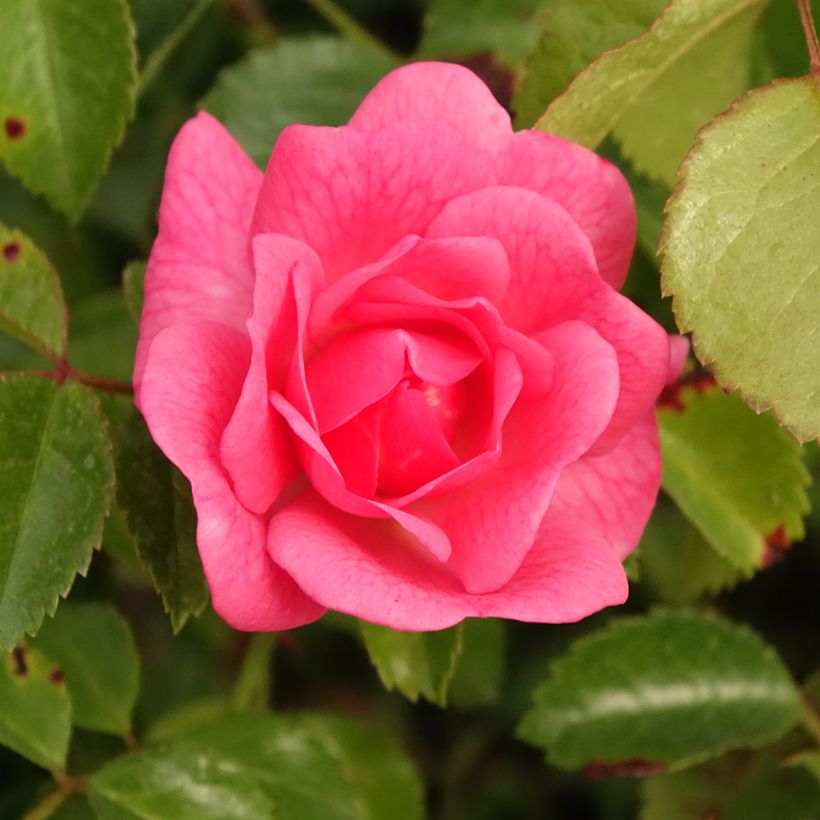



Plant habit
Flowering
Foliage
Botanical data
Rosa
x polyantha
Bees Paradise® Pink
Rosaceae
Rosier polyantha
Cultivar or hybrid
Other Dwarf and mini Roses
Planting and care
Bee's Paradise roses prefer a sunny location (at least 4 to 5 hours of sunlight per day), sheltered from the burning rays of midday and strong winds. They like loose, permeable, deep, and fertile soil. They prefer neutral to slightly acidic soil but will adapt to any garden as long as the soil is well-worked and sufficiently rich. To plant your rose, dig the soil well to a depth of 25 cm (10in) and place a base fertiliser such as bonemeal at the bottom of the planting hole. Remove your rose from its pot, place it in the hole and cover the top of the root ball with 3 cm (1in) of soil. Fill the hole and water generously to remove any air pockets. In dry weather, water regularly for a few weeks to aid root development. Provide your rose with special rose fertiliser to stimulate flowering.
Roses are often stained or unsightly in late summer, but this is not a problem for their development. These spots are not harmful to the rose, it is a natural phenomenon.
Planting period
Intended location
Care
-
, onOrder confirmed
Reply from on Promesse de fleurs
Roses by purpose
Haven't found what you were looking for?
Hardiness is the lowest winter temperature a plant can endure without suffering serious damage or even dying. However, hardiness is affected by location (a sheltered area, such as a patio), protection (winter cover) and soil type (hardiness is improved by well-drained soil).

Photo Sharing Terms & Conditions
In order to encourage gardeners to interact and share their experiences, Promesse de fleurs offers various media enabling content to be uploaded onto its Site - in particular via the ‘Photo sharing’ module.
The User agrees to refrain from:
- Posting any content that is illegal, prejudicial, insulting, racist, inciteful to hatred, revisionist, contrary to public decency, that infringes on privacy or on the privacy rights of third parties, in particular the publicity rights of persons and goods, intellectual property rights, or the right to privacy.
- Submitting content on behalf of a third party;
- Impersonate the identity of a third party and/or publish any personal information about a third party;
In general, the User undertakes to refrain from any unethical behaviour.
All Content (in particular text, comments, files, images, photos, videos, creative works, etc.), which may be subject to property or intellectual property rights, image or other private rights, shall remain the property of the User, subject to the limited rights granted by the terms of the licence granted by Promesse de fleurs as stated below. Users are at liberty to publish or not to publish such Content on the Site, notably via the ‘Photo Sharing’ facility, and accept that this Content shall be made public and freely accessible, notably on the Internet.
Users further acknowledge, undertake to have ,and guarantee that they hold all necessary rights and permissions to publish such material on the Site, in particular with regard to the legislation in force pertaining to any privacy, property, intellectual property, image, or contractual rights, or rights of any other nature. By publishing such Content on the Site, Users acknowledge accepting full liability as publishers of the Content within the meaning of the law, and grant Promesse de fleurs, free of charge, an inclusive, worldwide licence for the said Content for the entire duration of its publication, including all reproduction, representation, up/downloading, displaying, performing, transmission, and storage rights.
Users also grant permission for their name to be linked to the Content and accept that this link may not always be made available.
By engaging in posting material, Users consent to their Content becoming automatically accessible on the Internet, in particular on other sites and/or blogs and/or web pages of the Promesse de fleurs site, including in particular social pages and the Promesse de fleurs catalogue.
Users may secure the removal of entrusted content free of charge by issuing a simple request via our contact form.
The flowering period indicated on our website applies to countries and regions located in USDA zone 8 (France, the United Kingdom, Ireland, the Netherlands, etc.)
It will vary according to where you live:
- In zones 9 to 10 (Italy, Spain, Greece, etc.), flowering will occur about 2 to 4 weeks earlier.
- In zones 6 to 7 (Germany, Poland, Slovenia, and lower mountainous regions), flowering will be delayed by 2 to 3 weeks.
- In zone 5 (Central Europe, Scandinavia), blooming will be delayed by 3 to 5 weeks.
In temperate climates, pruning of spring-flowering shrubs (forsythia, spireas, etc.) should be done just after flowering.
Pruning of summer-flowering shrubs (Indian Lilac, Perovskia, etc.) can be done in winter or spring.
In cold regions as well as with frost-sensitive plants, avoid pruning too early when severe frosts may still occur.
The planting period indicated on our website applies to countries and regions located in USDA zone 8 (France, United Kingdom, Ireland, Netherlands).
It will vary according to where you live:
- In Mediterranean zones (Marseille, Madrid, Milan, etc.), autumn and winter are the best planting periods.
- In continental zones (Strasbourg, Munich, Vienna, etc.), delay planting by 2 to 3 weeks in spring and bring it forward by 2 to 4 weeks in autumn.
- In mountainous regions (the Alps, Pyrenees, Carpathians, etc.), it is best to plant in late spring (May-June) or late summer (August-September).
The harvesting period indicated on our website applies to countries and regions in USDA zone 8 (France, England, Ireland, the Netherlands).
In colder areas (Scandinavia, Poland, Austria...) fruit and vegetable harvests are likely to be delayed by 3-4 weeks.
In warmer areas (Italy, Spain, Greece, etc.), harvesting will probably take place earlier, depending on weather conditions.
The sowing periods indicated on our website apply to countries and regions within USDA Zone 8 (France, UK, Ireland, Netherlands).
In colder areas (Scandinavia, Poland, Austria...), delay any outdoor sowing by 3-4 weeks, or sow under glass.
In warmer climes (Italy, Spain, Greece, etc.), bring outdoor sowing forward by a few weeks.

































